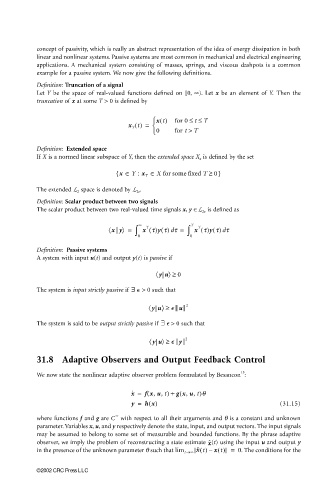Page 948 - The Mechatronics Handbook
P. 948
0066_frame_C31.fm Page 11 Wednesday, January 9, 2002 7:49 PM
concept of passivity, which is really an abstract representation of the idea of energy dissipation in both
linear and nonlinear systems. Passive systems are most common in mechanical and electrical engineering
applications. A mechanical system consisting of masses, springs, and viscous dashpots is a common
example for a passive system. We now give the following definitions.
Definition: Truncation of a signal
Let Y be the space of real-valued functions defined on [0, ∞). Let x be an element of Y. Then the
truncation of x at some T > 0 is defined by
x t() for 0 ≤ t ≤ T
x T t() =
0 for t > T
Definition: Extended space
If X is a normed linear subspace of Y, then the extended space X e is defined by the set
{ x ∈ Y : x T ∈ X for some fixed T ≥ 0}
The extended L 2 space is denoted by L 2e .
Definition: Scalar product between two signals
The scalar product between two real-valued time signals x, y ∈L 2e is defined as
T
〈 x | y〉 = ∫ ∞ x t()y t() t = ∫ T x t()y t() t
T
d
d
0 0
Definition: Passive systems
A system with input u(t) and output y(t) is passive if
〈|〉 0
yu ≥
∃
The system is input strictly passive if > 0 such that
yu ≥
〈|〉 u 2
The system is said to be output strictly passive if > 0 such that∃
yu ≥
〈|〉 y 2
31.8 Adaptive Observers and Output Feedback Control
15
We now state the nonlinear adaptive observer problem formulated by Besancon :
(
(
x ˙ = fx, u, t) + gx, u, t)q
y = h x() (31.15)
∞
where functions f and g are C with respect to all their arguments and q is a constant and unknown
parameter. Variables x, u, and y respectively denote the state, input, and output vectors. The input signals
may be assumed to belong to some set of measurable and bounded functions. By the phrase adaptive
observer, we imply the problem of reconstructing a state estimate (t) using the input u and output y
x ˆ
in the presence of the unknown parameter q such that lim t→∞ x ˆ t() x t()– = 0 . The conditions for the
©2002 CRC Press LLC

